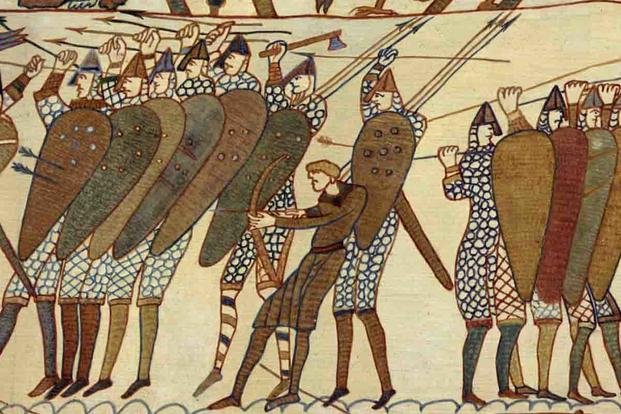Television and film, as any veteran knows, likes to take creative license with the facts, especially when it comes to getting details right. But those little things, as we learned in basic training, are what make us exceptional. For those of us in the military, it could be the difference between life and death.
No one is going to die because they don't know how much armor weighed in the 10th century. But getting little details wrong is also a missed opportunity to learn and teach something cool. Instead, these little nuisances continue to spread myths and false history and basically lie to our children.
Why don't they ever think of the children?
So, the next time you're sitting around watching some historically inaccurate gobbledygook, keep a lookout for a few things and feel free to drop these facts to anyone within earshot. You will look like you know what you're talking about, because some filmmakers sure don't.
1. It's Not Called "Chain Mail."
We don't care what your dungeon master calls it; this is the verbal equivalent of calling the robot that dispenses money an "ATM machine." "Chain" and "mail" are essentially the same thing, a series of interwoven rings on a massive scale.
Unless Xzibit is pimpin' medieval armor now, adding chains to the mail to make a double mail so you can chain while you mail (he's not), just choose to use one term or the other.
2. It Doesn't Matter How They Used a Toilet.
When a medieval warrior had to use the toilet while wearing armor, there's a good chance he just went to the privy, removed the parts of the armor that protected his bath and body works, and evacuated like a normal human being. It wasn't an ordeal, but everyone seems to think that it would be.
Knights in combat probably weren't thinking about answering the call of nature; they were listening for the call to advance (or, more importantly, retreat). If for some reason, they had to go that badly in the middle of a sword fight, they probably just went. It might even have discouraged the enemy, who knows. If they unexpectedly filled their armor, it was probably for a good reason. Or a Mongol horde.
3. Armor Didn't Weigh That Much.
There are movies that show knights being lifted onto horses via cranes, which is kind of ridiculous. Armor at the time was made of iron, bronze or steel, and an entire suit of armor donned for use in medieval combat didn't weigh hundreds of tons, even when it was made of iron.
That wouldn't make any sense. Knights accepted a certain amount of risk when they went to war, so wearing an inch-thick, 200-pound impenetrable iron suit just wasn't done. They still needed to be able to move.

A knight's armor weighed about 55 pounds, and even then, that weight was evenly distributed across the body. They might have needed a squire to help don the armor, but they didn't require cranes. After a while, they didn't even wear full suits; they wore only the plates that protected vital organs.
4. Knights Could Move Pretty Well.
Some seem to think that knights had a limited range of weapons and mobility because of the protection they needed. Knights who rode with a lance had a limited use of that weapon, but not because of the armor. It was because you can spear a serf conscript only once (maybe twice, if you line them up just right). Once the lance was used, they switched to a more versatile, less disposable weapon.
A medieval warrior running around with the maneuverability of Ralphie's younger brother in "A Christmas Story" makes about as much sense as one wearing 1,000 pounds of impenetrable armor. A knight needs to be protected but also needs to be able to ride, swing a sword and probably burn a peasant's cottage.

5. Buying Armor Wasn't the Only Way to Get It.
A custom-made suit of armor was an expensive undertaking for any lord or person of noble birth, so having it made by a famous armorer was out of reach for the commoner. But do we really think the common person went to the battle unarmored?
The commoner did what anyone would do when they need something essential: Buy the knockoff brand. Sure, it doesn’t have gold piping on it, but their bare chest also wouldn’t have an arrow in it. Did those pieces end up in museums? No. Did it save the commoner? Maybe, but it was better than just accepting a sharp instrument to the chest.

There was another way to go out and get the expensive armor, though. You could be the first to find one of the nobles who was not saved by their fancy-pants armor.
6. Women Also Wore Armor.
Admittedly, women in armor during the Middle Ages wasn't as common as men donning it, but it happened. And unless their armor was custom-made, odds are it was pretty uncomfortable. Joan of Arc kicked the British all around France wearing armor, and she did it so well, King Charles VII had a suit custom-made for her.
Joan of Arc's method was just one more way a commoner could get their own custom armor: Be an instrument of God instead of just sending people to meet him.
It was probably easier to find a dead noble and take his (or hers), though.
-- Blake Stilwell can be reached at blake.stilwell@military.com. He can also be found on Twitter @blakestilwell or on Facebook.
Want to Learn More About Military Life?
Whether you're thinking of joining the military, looking for post-military careers or keeping up with military life and benefits, Military.com has you covered. Subscribe to Military.com to have military news, updates and resources delivered directly to your inbox.
















